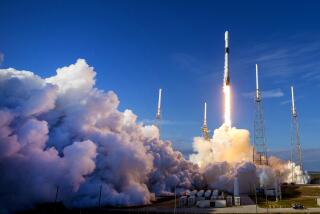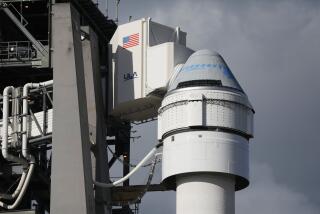Troubled Skies for a High-Flying Aircraft : Science: Setbacks plague program to send unpiloted planes to the edge of the stratosphere, but researchers remain hopeful.
- Share via
EDWARDS AIR FORCE BASE — Soaring almost seven miles above the Mojave Desert recently, a pilotless NASA research plane resembling a glider struggled against hurricane-force winds.
As it headed home through the heaving sky, the $1.5-million craft began to twist and turn violently. Ground handlers tried to regain control by radio, but the plane broke up in midair, its pieces drifting to Earth by parachute.
The incident was the latest setback for the Perseus program, NASA’s path-breaking but controversial effort to use inexpensive robot aircraft to study erosion of the Earth’s vital ozone layer and other global climate changes.
Scientists hope that high-flying, remote-controlled drones like the one that was destroyed can open the door to closer scrutiny of ozone and other gases in the stratosphere, that great slab of frigid air 10 to 30 miles above the surface that remains a little-understood scientific frontier.
In the near term, NASA wants to use Perseus to measure the impact on ozone of exhaust gases from the proposed high-speed civil transport, an updated version of the supersonic transport project, or SST, that was canceled by Congress in 1971.
But since Perseus test flights began at this sprawling desert air base a year ago, the $6-million program to develop the planes has been repeatedly delayed by mechanical and weather troubles. Although they were expected to fly to the low end of the stratosphere--about 15 miles up--Perseus planes have yet to reach 10 miles.
“I’d be lying if I told you I’m satisfied. I’m certainly dissatisfied we haven’t made more rapid progress,” said John S. Langford, president of Aurora Flight Services Corp., a small, 5-year-old Virginia firm that built the Perseus craft that crashed.
Moreover, some scientists worry that Aurora and NASA have unrealistic expectations of the Perseus project, and question whether the lightweight craft can loft adequate scientific instruments to the necessary heights.
“It’s clear that it is underfunded,” said Adrian Tuck, a respected ozone researcher for the National Oceanic and Atmospheric Administration. “The cheap, garage-electronics approach is not going to work.”
Perseus’ design borrows from the headline-making Daedalus aircraft, a 70-pound contraption that flew 72 miles from Crete to Santorini in 1988, powered solely by the legs of a Greek bicycle racer. The project was supervised by Langford, an MIT graduate who later enlisted several other Daedalus veterans to start Aurora in 1989.
Scientists hope Perseus drones will succeed the much larger, piloted aircraft such as converted U-2 spy planes and other onetime military craft that now are the workhorses of stratospheric research.
Such planes cost far more to build and operate, and carry risks to human pilots that are nonexistent with unmanned drones. Nor can piloted planes fly as high. Although the U-2 has a ceiling of 65,000 feet, Perseus is intended to soar up to 98,000 feet.
With wings stretching 59 feet from tip to tip, Perseus craft are driven by an 80 horsepower gasoline engine. To keep the power plant running in the stratosphere’s thin air, the craft carries a tank of liquid oxygen. It can accommodate up to 165 pounds of instruments, taking air samples through it nose.
NASA wants to put Perseus to work immediately studying the effect on stratospheric ozone levels of the high-speed civil transport.
Aircraft manufacturers believe there is a big market for the plane, which is intended to whisk large numbers of passengers between major cities three times as fast as conventional airliners. But the craft will spew exhaust gases including nitrogen oxides, which destroy ozone.
The SST was canceled by Congress amid concerns over nitrogen oxides, and aerospace firms are now trying to develop engines that burn most of those gases. NASA has been directed to assess such efforts.
Researchers had hoped to use Perseus in stratospheric studies this fall, but the craft was delayed by a series of problems.
As a cost-cutting measure, Perseus has no brakes, so it lands on Rogers Dry Lake, a vast natural runway at Edwards, about 100 miles north of Downtown Los Angeles. A number of flights had to be canceled last winter after rains soaked the lake bed. High crosswinds also hampered testing.
Perseus craft have suffered a number of mechanical problems as well. On one flight, a relief valve froze in the open position, causing the craft to dump liquid oxygen as it ascended. Another flight was aborted after a faulty sensor warned of a nonexistent fuel leak.
“It’s a young, innovative company which is trying to solve some very difficult problems,” said Steve Wegener, NASA’s physical science manager for Perseus, referring to Aurora, the plane’s maker. “They’re having problems they didn’t anticipate.”
“My personal sense is that they were a bit naive about what it takes to test-fly airplanes. They originally thought they could get 10 flights in 30 days. And they got nine flights off in four months.”
Langford, Aurora’s president, said part of the problem is that NASA has Perseus on a short budget leash, and engineers can’t test the craft and its components in wind tunnels and other ground facilities. That increases the risk of problems on the flight line or in the sky, he said.
Two copies of Perseus were being test-flown at Edwards. But after one drone came apart Nov. 22, NASA grounded the other pending a report by an investigation team headed by former astronaut Vance Brand, assistant chief of flight operations at NASA’s Dryden Flight Research Center, located at the base.
Jenny Baer-Riedhart, a NASA-Dryden official who oversees the Perseus program, said the craft was headed for a landing when “some type of dynamic instability” caused its wing to separate from the fuselage. She said Brand’s group was analyzing a long-range video of the incident to determine its cause.
Baer-Riedhart brushed aside any suggestion that NASA may cancel Perseus over the breakup and other problems, although she said it may be modified to correct any engineering problems that may be found by Brand’s team.
“Considering the guidelines we’re under as far as keeping costs fairly low, and the weather, and the type of technology that we’re trying to do, we’re fairly happy with the way we’ve been going,” she said.
Many scientists also remain supportive.
Jim Anderson, a Harvard professor of atmospheric chemistry who helped develop the aircraft, said that although researchers have good data on the lower regions of the stratosphere, the upper portion remains a mystery. Since piloted craft cannot fly that high, Perseus is crucial, he said.
“There’s a profoundly important missing piece of information that only Perseus can fill,” he said.
Other scientists are skeptical, however.
Tuck, of the National Oceanic and Atmospheric Administration, said although he supports the concept of Perseus, he does not think the aircraft can carry enough scientific payload.
Exploring the upper atmosphere is difficult and expensive, he said, and NASA should recognize that and spend more money developing a craft better suited for high-altitude research.
His concerns were echoed by Bill Burne, a professor of meteorology at Pennsylvania State University. Burne said a Perseus aircraft was scheduled to begin flying scientific instruments out of Darwin, Australia or the South Pacific island of Kwajalein last summer.
But the plane was not ready and the tests were postponed, he said. Now researchers are weighing the use of balloons for such flights, a less-than-perfect substitution because a balloon’s flight path cannot be controlled.
“It’s a big step down,” said Burne.
But Anderson said researchers have had great success in miniaturizing instruments in recent years, and carrying capacity is not a barrier to Perseus or its planned successor, Perseus B, designed to carry more than twice the payload.
He added that some researchers are uncomfortable with Perseus because they are used to piloted aircraft, which are more expensive and supported by larger bureaucracies. By contrast, Perseus was specifically designed as a shoestring operation, and that could threaten the careers of those associated with more traditional programs.
Perseus, Anderson said, “changes the context of how you do research. The minute you do that, you run into huge resistance.”





